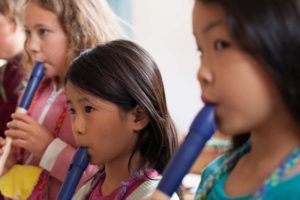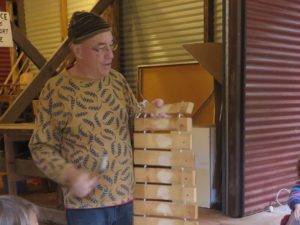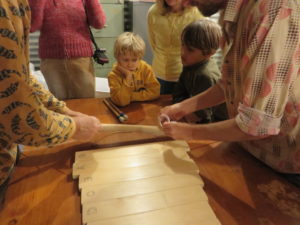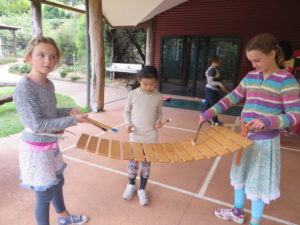MUSIC PROGRAM AT RAINBOW RIDGE SCHOOL
“Music is therapy. Music moves people. It connects people in ways that no other medium can. It pulls heart strings. It acts as medicine.”
Music is an important element in the Steiner Curriculum. According to Rudolf Steiner, the human being is a musical being, and the making of music is essential in experiencing what it is to be fully human. Music in the Steiner Curriculum awakens and nurtures the deep inner life of the child.
As the main lesson curriculum follows the very specific stages of child development, so also too does the music curriculum. Engaging the soul activities of thinking, feeling and willing in the child, the study and experience of the various elements in music arouse and cultivate the very forces necessary to be able to meet the challenges of the world with enthusiasm and confidence.
Rainbow Ridge School has a music program that is delivered by a music teacher once a week. Class teachers also bring their specific talents, skills and interests to the program and integrate music into as many aspects as possible in the daily, term and yearly rhythm of school life. Songs support and deepen the experience of Main Lesson themes.
What follows is a general overview of the Steiner music curriculum. It briefly describes the music activities in each grade in view of the understanding of child development that underlies the curriculum.
As Rainbow Ridge School still has combined classes, where the class teacher starts with class one, next year integrates to a class 1&2 and follows on with the same two classes to the end of Middle School, the class teacher and the music teacher need to carefully decide the time when to bring the appropriate musical experiences to both classes.
CLASS ONE
The six-or-seven year old children, still fresh from the spiritual world, just begin their evolution as a human being. They are very open to the outside environment. They experience music as a surrounding, permeating force. Singing freely in the “mood of the fifth” – pentatonic melodies that employ open intervals of the fifth, moving around the tone A – brings this floating, unfinished quality that is appropriate for the class one children.
A variety of instrumental sounds are used – for “tone colour” and mood only, not to accompany the singing with harmony or beat. The children sing songs about nature, the seasons and the magical world of elves, gnomes and fairies. Movement, dances and song games address the in-and-out breathing qualities we strive to nurture both on both the physical and the soul levels.
The class one teacher might use the lyre, and above all the experience of listening is cultivated.
The students learn to play recorder, which can be introduced as a separate main lesson or can be integrated in other main lessons by the class teacher. Depending on the skill of the teacher they may have a project with support from parents to make their own bamboo flutes.

CLASS TWO
Here, music continues to be presented so that it appeals to the feeling life of the child. Music in the “mood of the fifth” is gradually replaced by more purely pentatonic melodies. By the end of second class, there are pentatonic songs that have definite tonic ending-pentatonic major on G and pentatonic minor on E. The songs are about nature and the seasons, and also about the saints, heroes, and fable characters that the children encounter in their main lesson blocks.
Playing the recorder continues as the development of soul breathing. Class twos explore the polarities and contrasts in music between listening and making music, high and low tones, loud and soft, fast and slow, and the exploration of various tone colours. This happens, still without the use of formal musical terms, still in the realm of feeling. Some preparatory experiences are introduced as a prelude to composition and traditional notation, which begins formally in class three.
CLASS THREE
During class three most children go through the inner transformation that Rudolf Steiner called the “nine-year-change.” The child incarnates more fully into the physical body, leaves the magical world of early childhood, and experiences herself as an independent being separate from the world. A number of new musical experiences are now appropriate: singing songs in a major diatonic key, playing the recorder using the diatonic range and learning the rudiments of musical notation, though in an imaginative way. The keynote C is central now, providing a landing or grounding point, for the child who is at this stage in the incarnating process.
Sacred songs and folk songs are important, as are songs about house building, cooking, gardening, and telling time – key subjects in the class three curricula. As preparation for part-singing, the children learn songs in which they can experience call-and-response, drones, antiphony, ostinatos, and other steps toward singing in harmony. They’ll make music lesson books that contain their growing musical vocabulary and that show their new skills in regards to traditional musical notation.
The musical element of rhythm tied to beat is introduced in class three. Steiner speaks of beat as “driving us into our bones”, so that it is now appropriate for the nine-year-old who is entering more deeply into the physical body and the material world. Simple percussion instruments are used to explore beat, rhythm, and other qualities of tempo.
Through a workshop in 2015 the school built a humarimba and plans to build more with the help of students in a craft lesson. These instruments are introduced from class three onward.




Students are now ready to experience performing to an audience instead of staying in their class circle and just performing in their class for parents or at assemblies in the younger years.
This is the year when students start playing a string instrument at Rainbow Ridge School (see String Program).
CLASS FOUR
The children in class four are ready for another new set of musical experiences. With a proper preparation for part singing and harmony, the children will now be able to sing simple rounds, canons, descants and partner songs with grace and ease. Holding on to one’s own part while listening to the other and to the whole is challenging, and class four students are now ready to take on such an activity.
The curriculum includes Norse myths, local geography and history and the children can learn songs related to those periods. What they sing should express their growing strength and vitality and also their deepening inner life. Songs in minor and major keys are utilised, and the moods they engender are explored.
The students continue their study of music notation and with the main lesson block on fractions nicely complementing the learning of the time signature. Various metres are experienced and studied. By the end of the year the children should be able to sight-read simple melodies, both vocally and instrumentally.
CLASS FIVE
In Steiner Schools, class five – the fulcrum point of the Primary and Middle School – is usually referred to as the “Golden Age of Childhood”. The children realise or approximate a certain harmony and balance in their physical and emotional development. In addition to the study of Ancient Cultures there is an emphasis on the magnificent and inspirational culture of ancient Greece and the Greek ideals of grace, beauty and balance. The children strive toward this harmony, and their musical activities reflect and support this. Appropriate songs- such as “Glorious Apollo”, “Fair Moon” and “Iona Gloria”- are songs that bespeak of harmony and balance in form.
Australian History is an important study from class four onward and children learn Colonial and Indigenous songs which can accompany a class play.
The students continue to deepen their theoretical music education. They may study basic principles of composition, learning how to create a score using the traditional notation that was introduced in class three. Scales, as well as modes, are studied, and the musical key signature is explored more deeply.
The students continue to play their C recorders with greater complexity of musical pieces and other recorders can be introduced now.
CLASS SIX
In class six the students study ancient Rome. Therefore, this is the time for them to experience the Latin language through the many wonderful Latin songs and rounds available. During this study of Rome, songs that lend themselves to marching are particularly well suited to this age group. Marching patterns and forms can be created together by the students and teacher and carried out with precision and intention while singing.
Some teachers may start to move in their History lesson into the time of the Middle Ages. The voices of most of the children are still pure and unchanged, and singing plainchant or Gregorian chant is a form and style perfectly suited for the children at this time. The recorder appeared and came to prominence in the Middle Ages, and the medieval repertoire for the instrument is rich and it is rewarding . They can play the soprano, alto and tenor recorders.
CLASS SEVEN
In class seven a focus of study is the period of the Middle Ages and the Renaissance. The Renaissance was a period of cultural rebirth, world exploration and discoveries in science, astronomy and other areas. Since the recorder was still an important instrument during that time, the class seven students continue to play music for that instrument, with different versions of the instrument – soprano, alto and tenor – used.
Many of the children, both boys and girls, experience the changing voice during this year. While their vocal instrument is delicate and fragile, it is very important that they continue singing through the change. Much can be lost if the voice goes unexercised. The class teacher and music teacher honours the process of change, explains it and supports it by providing music that the changing voice can successfully sing. Songs with a limited vocal range in the middle to lower parts support this. As well the use of ostinatos and drones can help the changing voices find their way in the choral setting and feel empowered in their contributions.
CLASS EIGHT
Class eight is a year of challenges and changes. The students study the great revolutions – French, Russian and Industrial – and the human striving after toward freedom and the realisation of ideals. In their own development, the students are reaching the end of the seven-year cycle that began at age seven, and are now entering adolescence.
The music during class eight attempts to meet this turbulent, often disturbing, always inward, quality of the budding adolescent. Music with deep meaning and striving must be the basis of the musical experience during this special time. Ponderings about death, loss and the struggle to know oneself can be brought in song to meet this inward process. Songs about the ideals of freedom, equality and brotherhood are inspiring and uplifting to the class eight students. Songs that include riddles, puzzles or humour are also welcome as they lighten the sometimes grave mood of the class eight students. Continued work with the changing voice takes place, as does more theory (still presented in an imaginative way), composition, and increasingly complex part-singing.
Music in the Steiner Curriculum seeks to bring the living, healing presence of music into the life of the child, providing them with the opportunity to experience both their own individuality and their relationship to community. It provides a chance for the expression of the soul, a discipline for achieving skills and goals, and contributes to the awareness of what it means to be truly human.



